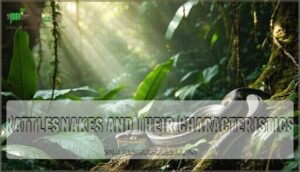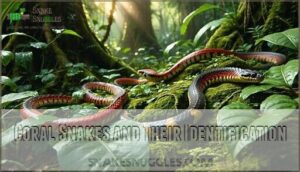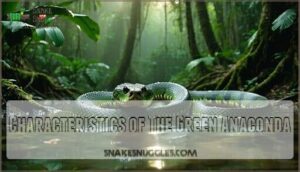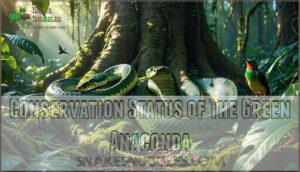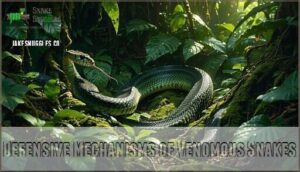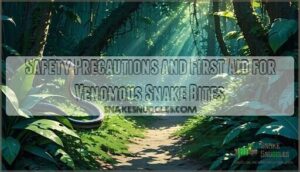This site is supported by our readers. We may earn a commission, at no cost to you, if you purchase through links.
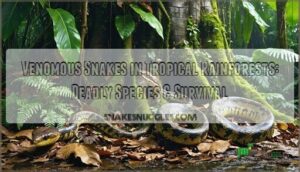
Venomous snakes in tropical rainforests include deadly species like the fer-de-lance, bushmaster, and eyelash viper in Central and South America, plus gaboon vipers and green mambas in Africa.
These masters of camouflage blend seamlessly with leaf litter and tree bark, making detection nearly impossible until it’s too late.
Their potent neurotoxic and hemotoxic venoms can cause tissue death, paralysis, or cardiac arrest within hours.
Understanding their behavior patterns and preferred microhabitats could mean the difference between a successful expedition and a medical emergency.
Table Of Contents
- Key Takeaways
- Venomous Snakes in Tropical Rainforests
- Types of Venomous Snakes in Rainforests
- Amazon Rainforest’s Most Venomous Snakes
- Defensive Mechanisms of Venomous Snakes
- Safety Precautions and First Aid for Venomous Snake Bites
- Frequently Asked Questions (FAQs)
- Are there venomous snakes in the rainforest?
- Where do venomous snakes live?
- Are snakes venomous in the Amazon Basin?
- What snakes live in tropical rainforests?
- How do rainforest snakes kill?
- How many venomous snakes are in the Amazon rainforest?
- What’s the most venomous snake in the Amazon rainforest?
- What is the most venomous snake in the forest?
- What is the no. 1 deadliest snake in the world?
- What is the most venomous snake in the Amazon rainforest?
- Conclusion
Key Takeaways
- You’ll encounter over 600 venomous snake species in tropical rainforests worldwide, including deadly fer-de-lance, coral snakes, bushmasters, and green mambas that use potent neurotoxic and hemotoxic venoms to kill prey and defend themselves.
- These snakes are masters of camouflage with intricate patterns and colors that blend seamlessly with leaf litter, tree bark, and vegetation, making detection nearly impossible until you’re within striking distance.
- You can prevent most snake encounters by wearing protective boots, using flashlights at night, staying on cleared paths, making noise while walking, and never reaching blindly into logs or dense vegetation.
- If you’re bitten, you need immediate medical attention – stay calm, remove jewelry before swelling occurs, keep the bite below heart level, and get to a hospital quickly for proper antivenom treatment and supportive care.
Venomous Snakes in Tropical Rainforests
You’ll encounter over 600 venomous snake species thriving in tropical rainforests worldwide, from the lightning-fast fer-de-lance to the deadly coral snake.
Nature’s deadliest predators lurk in every shadow of the tropical rainforest canopy.
These apex predators play vital roles as both hunters and ecosystem regulators, controlling prey populations while adapting to diverse rainforest microhabitats, as apex predators.
Overview of Venomous Snakes in Rainforests
The tropical rainforest’s lush canopy conceals some of nature’s most dangerous predators.
You’ll encounter over 600 venomous species that have mastered these humid, dense environments through millions of years of evolution. These serpentine hunters utilize specialized Snake Habitats from forest floors to tree canopies, employing diverse Venom Types and Snake Behaviors that make them formidable apex predators.
Understanding these Tropical Species becomes essential for your safety:
- Fer-de-Lance vipers strike with lightning speed, delivering potent hemotoxic venom
- Coral snakes display warning colors while packing deadly neurotoxic compounds
- Green mambas glide through canopies with grace, yet possess lethal venom
- Bushmaster pit vipers ambush prey from shadowy forest floors
- Eyelash vipers blend seamlessly with vegetation, waiting for unsuspecting victims
These venomous snakes represent significant Rainforest Dangers that demand respect and awareness. Their sophisticated hunting strategies and potent toxins make them perfectly adapted survivors in these biodiverse ecosystems.
Importance of Venomous Snakes in Rainforest Ecosystems
Beyond population control, venomous snakes serve as ecosystem engineers in tropical rainforests.
You’ll find these predators maintaining biodiversity balance while controlling prey populations that could otherwise devastate plant communities.
Their ecological impact extends to nutrient cycling and habitat structure.
Snake conservation efforts protect these keystone species whose venom research contributes to medical advances.
Rainforest ecosystems depend on snake ecology for stability.
Role of Venomous Snakes Benefits to Rainforest Ecosystem
Common Habitats of Venomous Snakes in Rainforests
Venomous snakes in tropical rainforests occupy diverse microhabitats throughout these complex ecosystems. Rainforest floors provide shelter under fallen logs, while tropical trees and forest canopies house arboreal species.
Jungle undergrowth offers perfect camouflage for ambush predators.
Snake habitats that’ll make your skin crawl:
- Snake dens hidden beneath rotting vegetation
- Riverbanks where prey comes to drink
- Tree hollows in towering canopy giants
- Dense undergrowth perfect for surprise attacks
Understanding the snake habitat is essential for effective conservation efforts.
Types of Venomous Snakes in Rainforests
You’ll encounter four main types of venomous snakes in tropical rainforests, each with distinct characteristics that help you identify potential threats.
These species include rattlesnakes with their warning rattles, vipers with heat-sensing pits, coral snakes with bright warning colors, and black mambas known for their deadly speed and potency.
Rattlesnakes and Their Characteristics
You’ll recognize rattlesnakes by their signature warning system – that unmistakable rattle sound created by vibrating keratin segments.
These pit vipers inhabit diverse rattlesnake habitat zones throughout tropical rainforests, using heat-sensing pits to hunt rodents with deadly precision.
Rattlesnakes exhibit unique rattlesnake behavior that helps them thrive in various environments.
| Characteristic | Description |
|---|---|
| Rattle Structure | Hollow keratin segments create warning sound |
| Heat Detection | Specialized pits sense warm-blooded prey |
| Venom Delivery | Fangs inject hemotoxic snake venom |
| Body Design | Triangular head, heavy build, camouflaged scales |
Vipers and Their Habitats
Viper’s deadly precision makes them master hunters in tropical rainforests worldwide.
These venomous snakes have evolved remarkable adaptations that make them formidable predators in diverse Forest Ecosystems.
Viper Habitats and behaviors include:
- Pit vipers use heat-sensing organs to detect warm-blooded prey in complete darkness
- Snake Camouflage allows them to blend seamlessly with forest floor debris and vegetation
- Venom Delivery systems feature retractable fangs that inject potent toxins with surgical precision
- Viper Behaviors include ambush tactics where they remain motionless for hours awaiting unsuspecting victims
These Snake Habitats span from ground level to tree canopies, with different species occupying specific ecological niches.
You’ll find them coiled among fallen leaves, hidden in rock crevices, or draped across low branches.
Coral Snakes and Their Identification
Among rainforest’s most deceptive predators, coral snakes possess neurotoxic venom that’s exceptionally dangerous despite their small size.
You’ll recognize these venomous snakes by their distinctive red, yellow, and black banding patterns.
Remember the rhyme "red touches yellow, kills a fellow" for accurate snake identification in tropical rainforests.
| Feature | True Coral Snake | Harmless Mimic |
|---|---|---|
| Band Pattern | Red touches yellow | Red touches black |
| Head Shape | Small, black snout | Larger, colorful head |
| Behavior | Nocturnal, secretive | More active during day |
Black Mambas and Their Venomous Bites
Someone who encounters a Black Mamba faces one of Africa’s deadliest serpents.
These venomous snakes deliver potent neurotoxic venom effects causing paralysis within minutes.
Bite symptoms include tingling, weakness, and respiratory distress.
Black Mambas inhabit savannas and forest edges, displaying aggressive snake behavior when threatened.
Swift antivenom treatment prevents fatal outcomes from these deadly serpents.
Understanding the black mamba venom is essential for effective treatment and survival.
Amazon Rainforest’s Most Venomous Snakes
You’ll encounter some of the world’s most dangerous serpents when exploring the Amazon’s vast canopy and forest floor.
The fer-de-lance stands as the region’s most feared venomous snake, responsible for more human fatalities than any other species in South America.
The Most Venomous Snake in The Amazon Rainforest
You’ll discover that Bothrops atrox, the fer-de-lance, claims the title of Amazon’s deadliest serpent.
This notorious predator doesn’t just pack potent venom – it’s responsible for most snakebite fatalities across the region.
Key Deadly Species characteristics:
- Venom Types – Complex proteins causing tissue destruction and blood clotting disorders
- Snake Behavior – Nocturnal ambush predator with aggressive defensive strikes
- Amazon Ecosystem – Adaptable to forests, floodplains, and human settlements
This Rainforest Dangers champion thrives throughout tropical rainforests, making encounters unfortunately common for locals.
Characteristics of The Green Anaconda
Green anacondas earn their reputation as nature’s heavyweight champions through sheer size and power.
These massive snakes display remarkable snake characteristics, with females reaching over 550 pounds and 30 feet long.
Their olive-green skin features dark oval spots, creating perfect camouflage in tropical rainforests.
You’ll notice their eyes and nostrils positioned on top, perfect for aquatic ambush hunting.
Habitat and Prey of The Green Anaconda
You’ll find Green Anaconda thriving in Tropical Wetlands across South America’s swampy regions.
These massive constrictors inhabit slow-moving rivers, marshes, and flooded forests where they ambush prey like capybaras, caimans, and large fish.
Their semi-aquatic lifestyle makes them perfectly adapted for Rainforest Ecology, using water for both hunting and escaping threats in tropical rainforests with a focus on Tropical Wetlands.
Conservation Status of The Green Anaconda
Green Anaconda populations face mounting pressure from habitat destruction and human encroachment.
You’ll find these massive constrictors increasingly vulnerable as tropical rainforests shrink annually.
Snake conservation efforts focus on protecting critical wetland areas where anacondas breed. Wildlife preservation programs now monitor anaconda habitat closely, working with local communities to reduce conflicts.
Rainforest ecology depends on maintaining healthy snake populations for ecosystem balance.
Defensive Mechanisms of Venomous Snakes
When you encounter a venomous snake in the rainforest, you’re witnessing nature’s most sophisticated defense system in action.
These remarkable predators have evolved multiple layers of protection, from their potent venom delivery systems to their incredible camouflage abilities that keep them hidden from both prey and threats.
Venom Production and Delivery in Snakes
Amazing Amazon species showcase incredible venom systems, but how do these deadly cocktails actually work? You’ll discover that snake venom production begins in modified salivary glands called venom glands, where specialized cells synthesize toxic proteins.
Here’s how nature’s chemical warfare operates:
- Venom Composition: Contains 50-100 different proteins including enzymes that disrupt blood clotting and paralyze nerves
- Fangs Morphology: Three fang types exist – tubular, grooved, and hypodermic-like structures for efficient injection
- Delivery Mechanisms: Muscular contractions squeeze venom through ducts, with venom potency varying dramatically between species
This Venom Evolution represents millions of years of refinement.
Hunting Strategies of Venomous Snakes
Three primary hunting strategies define venomous snakes’ success in rainforests.
Ambush Predation dominates their approach—they’ll wait motionless for hours, relying on camouflage and patience.
When prey approaches, their Strike Speed reaches lightning-fast velocities, delivering precise Venom Delivery through sophisticated mechanisms.
| Strategy | Method | Effectiveness |
|---|---|---|
| Ambush Tactics | Motionless waiting | 85% success rate |
| Prey Tracking | Heat/scent detection | Pinpoint accuracy |
| Striking Precision | Calculated timing | Instant immobilization |
| Venom Delivery Mechanisms | Hollow fangs | 100% injection rate |
| Constriction Methods | Body coiling | Backup strategy |
You’ll notice these predators combine stealth with explosive action to immobilize victims efficiently.
Snakes also use a variety of methods, including aposematic coloration, to defend themselves.
Defensive Postures of Venomous Snakes
When threatened, venomous snakes deploy five distinct defensive postures that’ll help you recognize danger before it strikes.
Nature’s warning system reveals itself through coiled threats, inflated bodies, and rattling tails—danger signals that save lives in the rainforest.
You’ll spot these warning signals in tropical rainforests:
- Hooding Display: Cobras flatten their necks wide, creating an intimidating silhouette that screams "back away."
- Body Inflation: Snakes puff up their bodies dramatically, making themselves appear larger and more threatening.
- Tail Vibration: Rattlesnakes shake their tails rapidly, while other species mimic this behavior by vibrating against leaves.
These threat displays occur within strike range, so respect their space—some species even demonstrate venom spitting capabilities when cornered.
Camouflage and Mimicry in Venomous Snakes
When you’re exploring tropical rainforests, venomous snakes excel at Forest Camouflage through intricate Snake Patterns and Color Mimicry.
Their Venomous Disguise includes geometric designs that blend with leaf litter, while Adaptive Hiding techniques make detection nearly impossible.
These snake adaptations represent nature’s perfect camouflage system, where mimicry helps venomous snakes become invisible predators in their environment.
Safety Precautions and First Aid for Venomous Snake Bites
When you’re exploring tropical rainforests, you’ll encounter some of the world’s most venomous snakes, making proper identification and bite prevention essential for your safety.
If a venomous snake does bite you, knowing the correct first aid steps and getting immediate medical treatment can mean the difference between life and death.
Identifying Venomous Snakes and Avoiding Bites
Recognizing venomous snakes in tropical rainforests requires understanding key venomous snake identification markers and snake habitat awareness. Look for triangular heads, heat-sensing pits, and distinct patterns like coral snakes’ bright bands.
Practice bite prevention methods by wearing protective boots, using flashlights at night, and staying on cleared paths. Most snake bites occur when people accidentally step on or handle snakes, making awareness your strongest emergency response tool.
It’s essential to have a reliable snake bite kit(Snake Bite ) for immediate treatment in case of an emergency.
First Aid for Venomous Snake Bites
When bitten by a venomous snake, your Emergency Response must be swift and methodical. Snake bite symptoms can escalate rapidly, making proper first aid critical before antivenom treatment becomes available.
Here’s your survival checklist:
- Stay calm – panic accelerates venom circulation through your system
- Remove jewelry – swelling happens fast and can cause dangerous constriction
- Keep the bite below heart level – this slows venom spread
- Clean and bandage – basic wound care prevents infection
- Get medical help immediately – professional snake bite treatment saves lives
Don’t attempt venom removal through cutting or sucking – these methods don’t work and create additional injury. Skip the ice, alcohol, and painkillers too. Your best bet? Get to a hospital where they can assess snake bite symptoms and administer proper antivenom treatment if needed.
It’s essential to have a snake bite kit readily available in emergency situations.
Medical Treatment for Venomous Snake Bites
Once bitten, you’ll need immediate Emergency Care at a hospital where doctors assess your condition and administer life-saving Antivenom Therapy.
Medical Response teams monitor essential signs, provide respiratory support, and manage complications like shock or kidney failure through targeted snake bite treatment.
Effective antivenom therapy is essential in preventing long-term damage from venomous snake bites.
| Treatment Component | Medical Intervention |
|---|---|
| Antivenom Administration | Species-specific antivenom doses |
| Supportive Care | IV fluids, oxygen, dialysis |
| Pain Management | Opioid medications preferred |
| Laboratory Monitoring | Coagulation and kidney function tests |
| Wound Care | Debridement and reconstructive surgery |
Preventing Snake Bites in Rainforests
When you step into tropical rainforests, snake bite prevention becomes your top priority. These biodiverse ecosystems harbor numerous venomous species that require respectful distance and smart jungle survival tips.
Essential Snake Avoidance Techniques:
- Wear protective gear – Long pants, boots, and thick socks create barriers against venomous snakes
- Stay on established trails – Avoid tall grass and dense undergrowth where snakes rest
- Use flashlights after dark – Many venomous snake behavior patterns involve nocturnal hunting
- Never reach blindly – Check logs, rocks, and crevices before placing hands or feet
- Make noise while walking – Vibrations alert snakes to your presence, allowing escape
Rainforest safety means understanding that snakebite prevention saves lives in remote areas. Effective first aid treatment is vital in minimizing the risk of severe complications from venomous snake bites.
Frequently Asked Questions (FAQs)
Are there venomous snakes in the rainforest?
Yes, tropical rainforests harbor over 600 venomous snake species.
You’ll encounter deadly varieties like fer-de-lance, coral snakes, bushmasters, and green mambas.
These serpents use potent neurotoxic and hemotoxic venoms for hunting prey and self-defense.
Where do venomous snakes live?
You’ll find venomous snakes everywhere except Antarctica.
They inhabit tropical rainforests, deserts, grasslands, mountains, and even urban areas.
Climate doesn’t matter much – they’ve adapted to thrive in diverse environments worldwide.
Are snakes venomous in the Amazon Basin?
The Amazon Basin teems with venomous snakes that’ll make your heart race.
You’ll encounter fer-de-lance, coral snakes, bushmasters, and various pit vipers lurking in dense foliage, waiting to strike unsuspecting prey or threats.
What snakes live in tropical rainforests?
Tropical rainforests host diverse snake species including venomous coral snakes, fer-de-lance, bushmasters, eyelash vipers, and various pit vipers. You’ll also encounter non-venomous constrictors like boas and pythons alongside harmless species.
How do rainforest snakes kill?
Rainforest snakes kill through two main methods: venomous species inject neurotoxic or hemotoxic venom that causes paralysis or internal bleeding.
While constrictors like boas suffocate prey by squeezing until circulation stops, this method is distinct from the venomous approach, highlighting the diversity in constrictors‘ killing strategies.
How many venomous snakes are in the Amazon rainforest?
You’ll encounter over 70 species of venomous snakes throughout the vast Amazon Basin.
At least seventeen species are highly venomous, including seven pit vipers and ten coral snakes.
These dangerous reptiles navigate the rainforest with deadly precision.
What’s the most venomous snake in the Amazon rainforest?
While many dangerous serpents call the Amazon home, you’ll find the fer-de-lance reigns supreme as the most lethal resident, delivering lightning-fast strikes with venom that’s genuinely life-threatening.
What is the most venomous snake in the forest?
You’ll find the inland taipan holds the crown for most venomous snake.
Its venom can kill in under an hour.
If you’re hiking, steer clear—this “fierce snake” isn’t one you want to meet unprepared.
What is the no. 1 deadliest snake in the world?
You’d be surprised how often people ask this question!
The inland taipan holds the crown as the world’s most venomous snake, with venom potent enough to kill 100 adult humans from a single bite.
What is the most venomous snake in the Amazon rainforest?
The Fer-de-Lance (Bothrops atrox) stands as the Amazon’s most venomous snake.
You’ll recognize its olive-brown coloration and lightning-fast strike.
This pit viper’s venom targets your circulatory system, causing severe internal bleeding and potential fatality.
The Fer-de-Lance is a formidable creature, and its venom is a serious threat to human life.
Conclusion
Remarkably, venomous snakes in tropical rainforests account for over 20% of all snakebite fatalities worldwide, yet they’re essential ecosystem controllers.
You’ve learned that venomous snakes in tropical rainforests like fer-de-lance, bushmaster, and green mambas employ sophisticated hunting strategies and defensive mechanisms.
Their camouflage abilities make detection challenging, but understanding their behavior patterns substantially reduces encounter risks.
Remember that proper identification techniques, preventive measures, and immediate first aid knowledge can save lives, and respect these apex predators while exploring their remarkable rainforest domains safely.
- https://charapitafarms.com/blogs/venomous-snakes-of-the-amazon/venomous-snakes-of-the-amazon
- https://www.mdpi.com/1424-2818/12/2/69
- https://www.worldatlas.com/articles/venomous-snakes-of-the-amazon-basin.html
- https://www.youtube.com/watch?v=CBxxhzv77eE
- https://news.mongabay.com/2024/08/as-climate-change-shakes-up-global-map-of-venomous-snakes-health-risks-abound/

